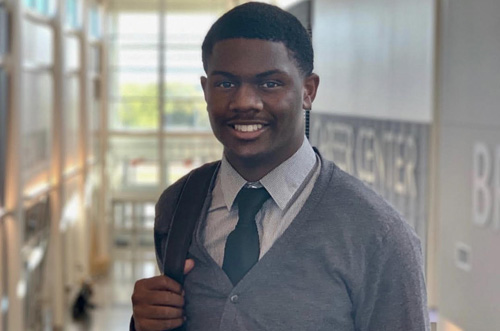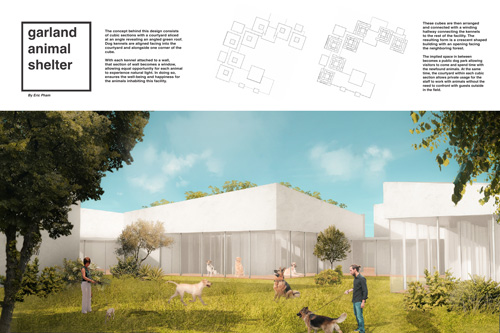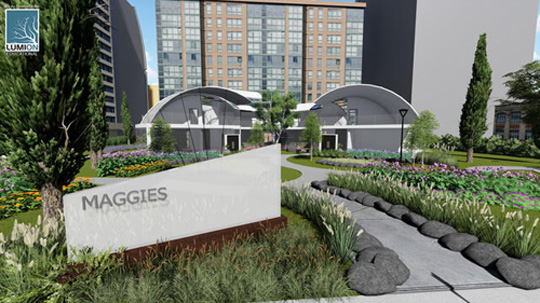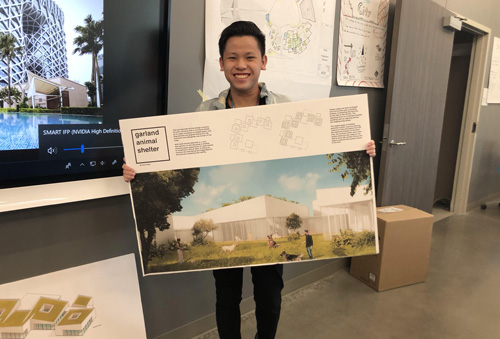The hard work of teachers Kurt Ortley and Stephanie Edwards is reflected in the successes of students in the architecture program at the Gilbreath Reed Career and Technical Center.
The students have participated in the design of several important projects including Garland’s new animal shelter, a greenhouse at GISD’s Herfurth Elementary School, the Maggie Center for cancer patients, a Winter Wonderland project at GRCTC, Parking Day Dallas competition and more. (Additional information about greenhouse and animal shelter below.)
There are multiple facets to architecture and Ortley and Edwards want to be sure that the students understand them.
“Architecture is rich in information so we try to give a good overview of everything that we can from sketching to computer programs, design, theories and construction techniques.”
About 18-20 percent of students go on to study architecture or interior design in college. Those who do not enter a related field still benefit from skills they learn in the program.
“One benefit is that we’ve given students an opportunity to see what they are interested in without spending too much time and money pursuing something that they do not want to do long-term,” Edwards said. “But we still don’t want that child to walk away from GRCTC with nothing, so we try to cultivate a process of thoughtfulness and empathy with others as well as problem-solving skills. Those lessons won’t leave them once they begin a different line of work.”
In addition to the projects and classroom work, the teachers have had other architects in as guest speakers. They have also invited professors from UT Arlington to talk about urban planning and a contractor to discuss the construction side. Hearing from various people involved in architecture and building helps to expand students’ knowledge.
“This program is really about developing deep thinkers and problem solvers,” Ortley said. “We have to focus on three dimensions, on the built form, on space, but through theory, through technology, through the integration of the hard sciences and the arts, we actually produce students who can think and solve problems. This is something that is really important.”
Another important element is the notion of craft and the students taking pride in what they produce and ownership of the projects they are a part of. The teachers want students to know that through this craft, they have something to offer and they can make the world a better place.
Edwards added that the students learn through intentionality.
“You can be intentional about the projects you select if you are at that point,” she said. “We’ve started to bring projects with a heart. We want to convey to the students that if they approach their lives with this intentionality whether it be for thoughtfulness and problem solving or craft, they can start to design the life they want to live.”
Ortley said that it is a powerful moment when they realize that they can have an idea that has power and the manifestation of that idea, something they dreamed up, is going to impact students for years to come.
They also get to use their skills in an international competition in which students create a learning environment for a developing nation. The students learn to ask the right questions and to understand the lives of the users of the building. Each situation is different and might include constraints such as no electricity, no running water, no technology and more. Important lessons about design and architecture, as well as about life, different cultures and gratitude are learned.
There is also an annual, affordable New York trip during which the students see various types of architecture. There is space for 16 students. Attendance is on a first come, first served basis.
Edwards and Ortley agree that the architecture program at the GRCTC is fun. There is an opportunity for creativity and a chance to play with lots of really fun toys like virtual reality, laser cutting and 3D printing and more.
Herfurth ES greenhouse project
Veronica Flores, Emily Saavedra and Sabryn Philpot participated in the greenhouse project which is about to reach the building stage. The GRCTC students’ design had to be approved by the school and the city of Garland. Flores is responsible for the Dr. Seuss theme in the design. Saavedra shared that she enjoyed putting in the work and effort and seeing the project come to life. She plans to pursue a career in architecture.
Philpot, who also wants to be an architect, said that it had been a great experience.
“We designed it. It’s a good feeling to know that it is going to get built and we are not even architects yet,” she said.
The students worked together using the best skills of each. Saavedra has good computer skills. Philpot, who is good at drawing, produced the sketches and Flores came up with a great theme.
Garland animal shelter project
Eric Pham, whose home school is North Garland HS, and Treyvon Perry, who goes to Rowlett HS, are both honored to have their designs submitted for Garland’s new animal shelter. They agreed that the scope of the project was a little overwhelming at 25,000 square feet.
“It also started to get to me more because in residential, I think about humans and how they live but with the shelter, it’s how animals are going to function in their temporary home,” Perry said. “I had to keep that in mind to design it. I wanted to create a building that was pleasing to humans but comfortable to animals.”
 The GRCTC students interacted with a volunteer from the animal shelter to gather information about what was needed and the class did extensive research.
The GRCTC students interacted with a volunteer from the animal shelter to gather information about what was needed and the class did extensive research.
Both plan to pursue an education in architecture at UT Arlington and both have been interested in architecture since they were young children. Perry used Legos to create structures. Pham loved building things using the game Minecraft.
“That’s what started my interest in architecture,” he said. “I remember before then I was planning to be a doctor but once I found that game, it clicked that I wanted to be an architect.”
Pham said that the creative side of architecture is what draws him in. He likes that he gets to experience the space around him.
“It affects everyone every day and inspires me to see what I can do and what I can create in order to evoke an emotion or do something for society,” he said.
Perry is most interested in the process of design.
“I love the creative side but the part that really interests me is that when you design a house, for example, you’re designing a space where people will live and thrive,” he said. “I feel like it’s really important.”
 Perry also helped design the Maggie Center, a facility for cancer patients. The idea was to design a building for patients that needed a place to go where there were more people who understood their situation. He said that he thought about who would be using the building to decide how it should be designed.
Perry also helped design the Maggie Center, a facility for cancer patients. The idea was to design a building for patients that needed a place to go where there were more people who understood their situation. He said that he thought about who would be using the building to decide how it should be designed.
“I gave it a circular design with a tree in the middle and wherever you go, you are going to see this tree which is going to symbolize peace,” Perry said.
Pham and Perry feel fortunate to be a part of the architecture program and to get to attend the GRCTC.
“The reason to get involved in the program is the immense amount of opportunities that it offers,” Pham said. “For example, you’d think that the city council would approach only licensed architects about the shelter project, but here they are approaching students, giving us the opportunity to share our voices and creative side and ideas.”



